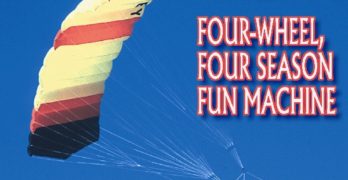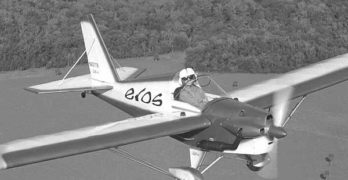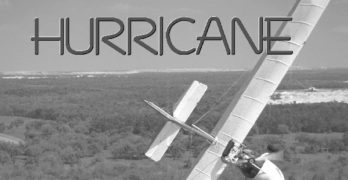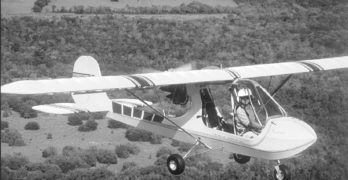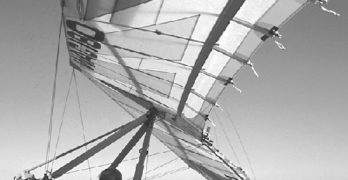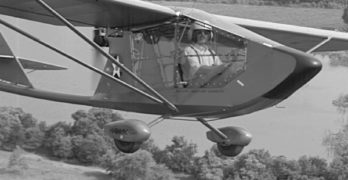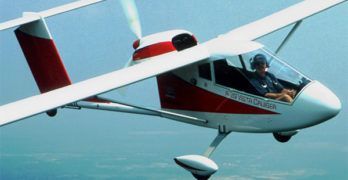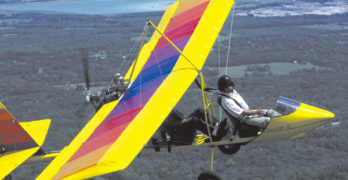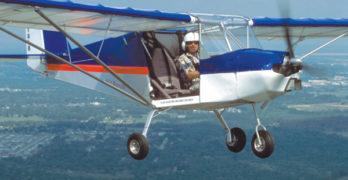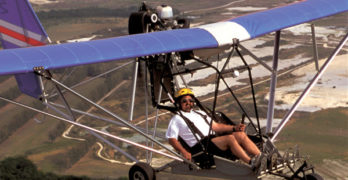Taking a broader view, this is similar to other forms of aviation. One only need look at airliners. From the outside, they’re virtually identical except in size, and for good reason. Airliner designers have discovered the optimal ways to build jets that accomplish their narrowly defined mission of speedy transportation.
On the light end, essentially the same can be said for trikes, or for that matter, for most types of ultralights. Fortunately, however, the purpose of fun aircraft remains widely varied, and that forces an interesting assortment of sport flying machines.
In this month’s Ultralight Flying! Pilot’s Report, we’ll look closely at the Para-Ski powered parachute. I believe you’ll agree it stands apart from the rest.
Versatility a Goal
Para-Ski International describes their machines as “the ultimate ATV/ASV (all terrain/all season vehicle).” It may sound like a big boast, but I think you’ll see Para-Ski may be able to honestly earn the title.
Search Results for : Electric
Not finding exactly what you expected? Try our advanced search option.
Select a manufacturer to go straight to all our content about that manufacturer.
Select an aircraft model to go straight to all our content about that model.
Eros
You know TEAM Aircraft. The Manchester, Tennessee company achieved success and notoriety by making inexpensive wood aircraft. They’ve been at it for more than a decade, selling in excess of 1,000 kits, an overwhelming majority of which are completed and flying. The company is also
one of the most-respected companies in light aviation.
One of their models has been the half-VW-powered miniMAX. However, for the 1996 season, the Eros brought further recognition of the continuing work of innovative designer Wayne Ison and his staff.
Published in Light Sport and Ultralight Flying
Seating
Single seat
Empty weight
345 pounds
Gross weight
625 pounds
Wingspan
26 feet 5 inches
Wing area
118 square feet
Wing loading
5.3 pounds/sq ft
Length
16 feet
Height
5 feet
Load Limit
+5.5 Gs, -3 Gs
Fuel Capacity
5 or 10 gallons
Kit type
Construction
Build time
350-450 hours
Set-up time
20 minutes
Standard engine
Rotax 503 dual carb
Power
52 horsepower
Power loading
12 pounds/hp
Max Speed
90 mph
Cruise speed
85 mph
Stall Speed (Flaps)
36 mph
Never exceed speed
110 mph
Rate of climb at gross
1,200 fpm
Takeoff distance at gross
150 feet
Landing distance at gross
250 feet
Standard Features
Enclosed cockpit, detachable wings, steerable tailwheel, 4-point pilot restraint harness, wood landing gear, big wheels, 5-gallon fuel tank, prop spinner, round wing tips, fiberglass cowling and boarding step insert.
Hurricane Ultra 103
In barely a dozen years, the original Phantom has gone through at least four changes of ownership I can clearly recall. One of the imitators, the Avenger, ceased and was restarted only to stop again (and who knows, maybe it will live on yet?). Another imitator, the Spitfire, has endured at least three owners I can think of, and yet it, too, continues to be an available aircraft to this day. Finally, the Hurricane left the hands of founder Donnie Eccker and was passed to present-day owner Mike Kern.
Published in Light Sport and Ultralight Flying
Seating
Single seat
Empty weight
250 pounds
Gross weight
500 pounds
Wingspan
28 feet 6 inches
Wing area
147 square feet
Wing loading
3.4 pounds/sq ft
Length
16 feet 9 inches
Height
8 feet 3 inches
Load Limit
+6 Gs, -4 Gs
Fuel Capacity
5 gallons
Kit type
Assembly
Build time
80-100 hours
Set-up time
30-40 minutes
Standard engine
Rotax 447
Power
40 horsepower
Power loading
12.5 pounds/hp
Cruise speed
55 mph
Stall Speed
26 mph
Never exceed speed
80 mph
Rate of climb at gross
850 fpm
Takeoff distance at gross
100 feet
Landing distance at gross
120 feet
Standard Features
Flat-bottomed wing airfoil, full-span ailerons, mechanical drum brakes, steerable nosewheel, 4-point shoulder harness, 6-inch aluminum wheels, windshield, pod.
Hornet
Let’s cut right to the chase. Flying the Hornet for the second time in a couple of years (the second flight was in April ’96), I experienced a most disconcerting quality: flutter. While I have many good things to say about the Hornet, this one experience elbows its way to the front of the line. Easing into the “Pilot’s Report” on the Hornet simply isn’t possible when such an experience dominates my thinking.
Published in Light Sport and Ultralight Flying
Seating
2, tandem
Empty weight
475 pounds
Gross weight
1,000 pounds
Wingspan
27 feet 6 inches
Wing area
138 square feet
Wing loading
7.2 pounds/sq ft
Length
20 feet
Height
6 feet
Fuel Capacity
9 gallons
Kit type
Construction
Build time
250-400 hours
Standard engine
Hirth 2703
Power
55 horsepower
Power loading
18.2 pounds/hp
Cruise speed
100 mph
Never exceed speed
140 mph
Rate of climb at gross
500 fpm
Takeoff distance at gross
400 feet
Landing distance at gross
250 feet
Standard Features
Electric start, steerable nosewheel, pneumatic suspension on all wheels, hydraulic brakes, aluminum wheels, large tires, electric flaps, electric horizontal stabilizer trim, dual aileron control circuits, dual elevator control circuits, adjustable seats, disassembles for trailering; wings, fuselage and empennage factory-assembled.
XP Racer
More than one European writer has called the single-seat Air Création Racer “the best ultralight in the world.” That’s a pretty big statement in a world full of wonderful recreational aircraft. Can it measure up? The short answer is, “Yes, very possibly it can!”
The best ultralight in the world? Really? Well, this is too sweeping a statement. No one knows which ultralight is truly the best because best is different for every person. What is best for you may not be best for me.
This very point has crystallized my response to many pilots who ask me at airshows, “You’ve flown everything. What should I buy?” I can’t answer the question because I don’t know what you want. Only after a lengthy conversation and watching you fly could I even hazard a guess about the best ultralight for you. Even then, it’s too likely I’d be wrong.
Nonetheless, some aircraft are clear winners and others aren’t so strong.
Hawk Plus
CGS’ new Hawk Plus
As the year 2000 approaches, computer programmers may be sweating that Y2K bug we’ve all heard way too much about. Ultralight enthusiasts, on the other hand, will be celebrating the completion of two full decades as a member of the aviation community. Throughout the 1980s and 1990s, a lot has happened.
This newest community of pilots and designers learned a great deal. Accidents are far lower than in the “old” days, and equipment is far better. Specifically, ultralight aircraft designs are the best we’ve seen, with many reliable brands offering airworthy sport-flying machines.
Buyers of ultralights include those lightweight enthusiasts who enjoy Part 103’s freedom from FAA licenses, registration or certification. That’s why ultralights can be bought for $10,000 to $15,000, and you don’t need an FAA ticket to fly one legally. That fact practically assures that ultralights will stay on the radar of many aging baby-boomer pilots.
Aeroprakt’s A-20 Vista Cruiser
UPDATE–November 2008: According to FPNA, an American company with a business relationship to A-20 producer Aeroprakt, the A-20 has been discontinued. Please contact FPNA for more information (contact info at end of article).
Two summers ago Americans saw a new aircraft from a Ukrainian company called Aeroprakt as U.S. importer Spectrum Aircraft brought in the A-22 Valor. It would be only the first in a fleet of new microlights.
Later another model from Aeroprakt appeared. In fact, the Vista series comprises 5 models, all variations on a basic theme that is nothing like the Valor. At present, the Ukraine enterprise has no less than nine models including the Valor, Vista, Cruiser, V-STOL, V-SS, Vulcan, Vulcan-SS, Victor single engine, Victor twin, and Viking. Four of this series are twin-engine aircraft, none are alike, and one is a 4-seater. By any measurement, this is quite an accomplishment from a company less than 10 years old and rising from the ashes of the failed Communist empire.
Super Drifter XL with Rotax 912
Considered by many to be a workhorse, the Super Drifter XL shows refinement and features that make it seem like a “luxury ultralight.” Leza AirCam, the newly renamed producer of this venerable ultralight, has equipped the top-of-the-line model with nearly every option in their price list. Conclusion: While it will cost you a bundle, you should be satisfied with this ultralight for many years.
How is this Super Drifter XL different from the Super Drifter that I evaluated almost 3 years ago? According to Denny Franklin – yes, that same icon of the Maxair days when the Drifter was a youngster – the XL is a significant redesign of the original Super Drifter 912 flown in 1998.1 It has seen numerous changes to make the veteran design work better with the big 80-hp Rotax 912 situated at the rear of the wing.
What’s New With the Super Drifter XL?
The Super Drifter XL has an extended fuselage – meaning the boom tube and its fuselage “pan” – to position the front seat 5 inches further forward.
French Quick-Build 2 Seater
One of the most popular club planes in France is widely used by instructors in that country. Now we welcome the Sky Ranger to North American skies.
In France, as with much of Europe, many ultralights are owned by aero clubs which frequently manage recreational airfields throughout the continent. Run a little differently in each location, they provide common ways for average pilots to fly and for newcomers to be introduced to flight. Virtually all aero clubs provide instruction, often through associated flight schools. Clubs also own and maintain aircraft – lots of them. This has worked especially well with sailplanes; Europe has more than twice as many sailplanes as the United States and several times the pilot population. Ultralight enthusiasts have followed this example.
The Sky Ranger arrived in the mid-1990s at French ultralight aero clubs that dot the landscape, and has done very well. U.S. importer Sabre Aircraft says, “It’s the most popular ultralight in France, especially with the flight schools.” In more than just 6 years, the company claims deliveries of about 500 aircraft.
M Squared’s Breese 2
Customers spoke and M-Squared acted. This proves the marketplace works, where customers “vote” with every dollar spent to acquire certain products. More importantly to pilots, this fact explains why a review of M-Squared’s new 2-seater – the Breese 2 – is good for customers.
Customers liked what M-Squared was doing. The 1996 company startup took a popular Quicksilver airframe design, added struts and beefed up the airframe to accept engines as large as the 100-hp Rotax 912S. But pilots also liked the way the original Quicksilvers (which are lighter) flew and handled. Being in business to serve customers, M-Squared acted appropriately.
Paul Mather and M-Squared responded to requests for a lighter version of their 2-seat Sport 1000 in a series of steps. First came the single-surface wing Sprint 1000, which dropped a few pounds by not using the big pod of the first Sport 1000. Then came the Breese SS (single-surface) and Breese DS (double-surface) single-seaters, which were obviously lighter and more agile.


